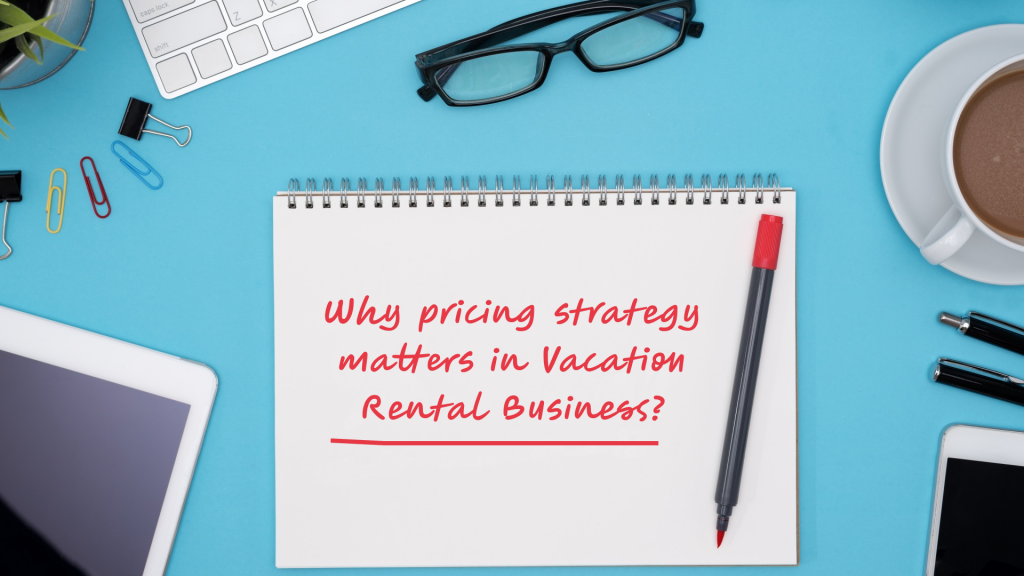In the competitive realm of vacation rentals, a lack of a well-defined pricing strategy can lead to missed opportunities, compromised profitability, and an erratic journey for property owners. Without a guiding compass, hosts may struggle to attract guests, optimize bookings, and adapt to the dynamic landscape of demand and supply.
In this blog, we illuminate the pitfalls of sailing without a strategic pricing plan, emphasizing the critical role it plays in the success of your vacation rental venture. Join us on this exploration, where we not only unravel the challenges but also provide concrete solutions to empower your property for sustained prosperity.
Why Pricing Strategy Matters in Vacation Rental Business?

In the dynamic realm of vacation rental management, the significance of a well-crafted pricing strategy cannot be overstated. Let’s delve into the crucial aspects to understand the direct linkages, illuminating why this is more than just a strategic move—it’s the lifeline of your rental business.
1. Maximizing Occupancy Rates:
A finely tuned pricing strategy ensures optimal occupancy rates by strategically adjusting rates based on demand. By offering competitive rates during off-peak seasons or adjusting prices in response to local events, your property becomes more attractive, leading to increased bookings and higher occupancy rates.
2. Enhancing Revenue Potential:
A robust pricing strategy transcends the mere act of attracting bookings; it’s about maximizing revenue per booking. Strategic pricing identifies periods of high demand, allowing you to adjust prices accordingly. This results in not just more bookings but bookings at rates that optimize your income potential.
3. Building Guest Loyalty:
Consistent, fair pricing builds trust with guests, fostering loyalty and encouraging repeat bookings. Through dynamic pricing, you can reward returning guests with exclusive discounts or special offers. This not only ensures guest satisfaction but also creates a loyal customer base that consistently chooses your property.
4. Staying Competitive in the Market:
In a market saturated with options, a dynamic pricing strategy ensures your property remains competitive. Regular analysis of competitor pricing, coupled with strategic adjustments based on local demand and industry trends, positions your property as an attractive and viable option in the eyes of potential guests. This competitiveness translates into more bookings and sustained business growth.
5. Adapting to Market Dynamics:
The vacation rental landscape is ever-changing. A well-informed pricing strategy allows hosts to adapt swiftly to market fluctuations, ensuring that your property stays relevant and profitable. By staying ahead of market trends, you position your property as a dynamic and sought-after option, ensuring continued success in the face of evolving consumer behavior.
In summary, the connection between pricing strategy and these key aspects lies in the strategic decisions hosts make to align their pricing with market dynamics, guest expectations, and competitive landscapes. Crafting and implementing a tailored pricing strategy isn’t just a choice—it’s a fundamental necessity for long-term success, directly influencing occupancy rates, revenue potential, guest loyalty, competitiveness, and adaptability in the vacation rental business.
Factors to Consider While Creating Pricing Strategy

Crafting an effective pricing strategy for your vacation rental property is a nuanced process that requires a comprehensive examination of various critical factors. Let’s meticulously explore each element, unraveling not only its importance but also its detailed impact on shaping a successful pricing strategy.
Expenses
- Operational Costs: Scrutinize day-to-day operational expenses such as utilities, maintenance, and cleaning services.
- Technology and Services: Consider the expenses associated with property management systems (PMS), booking platforms, and other technology services that contribute to the efficiency of your operations.
- Seasonal Variances: Analyze how expenses fluctuate with the seasons. For instance, heating costs in winter or landscaping expenses in summer.
A detailed understanding of expenses ensures that your pricing strategy not only covers essential costs but also accounts for the technology and services that enhance the overall guest experience.
Your Vacation Rental Market
- Seasonal Demand: Examine seasonal demand patterns, identifying peak booking periods and understanding when demand is likely to dip.
- Local Events: Take into account local events and festivals that could impact demand and pricing.
- Competitor Landscape: Analyze the pricing strategies of neighboring vacation rentals, considering their amenities, occupancy rates, and overall appeal.
By delving into these details, you can dynamically adjust your pricing to align with the ebb and flow of your local vacation rental market.
Guest Expectations
- Essential Amenities: List essential amenities that guests expect, from well-equipped kitchens to Wi-Fi.
- Additional Services: Consider extra services that enhance the guest experience, such as airport transfers, cleaning services during the stay, or personalized concierge services.
- Quality Standards: Maintain high-quality standards in terms of cleanliness, comfort, and overall guest satisfaction.
By aligning your pricing with these detailed guest expectations, you not only meet but exceed their anticipated value, fostering positive reviews and repeat bookings.
Competitor Pricing
- Rates: Compare not only nightly rates but also any additional fees or discounts competitors may offer.
- Services and Amenities: Scrutinize the services and amenities provided by competitors, identifying areas where your property can differentiate itself.
- Booking Platforms: Analyze the presence of competitors on various booking platforms to understand their visibility and appeal to potential guests.
A detailed analysis of competitor pricing allows you to strategically position your property for maximum competitiveness.
Industry Trends
- Technology Integration: Explore trends related to technology adoption, such as smart home features, contactless check-in, or virtual concierge services.
- Sustainability: Consider industry trends related to sustainability and eco-friendly practices.
- Guest Preferences: Stay informed about evolving guest preferences, whether it’s a demand for unique experiences or a focus on health and wellness amenities.
By incorporating these industry trends into your pricing strategy, you not only stay relevant but also anticipate and meet the changing needs of your target audience.
In conclusion, the success of your vacation rental pricing strategy lies in the meticulous examination and understanding of these factors. By immersing yourself in the intricate details of expenses, local market dynamics, unique value proposition, guest expectations, competitor pricing, and industry trends, you can craft a pricing strategy that not only meets current market demands but also anticipates future trends, fostering long-term success.
Crafting a Highly Effective Vacation Rental Pricing Strategy

Crafting a winning pricing strategy for your vacation rental property involves more than theoretical concepts. Let’s delve into detailed steps on how hosts can implement each facet of a highly effective pricing strategy.
Streamlining Operational Costs for Maximum Profitability
To maximize profitability, hosts should initiate a comprehensive review of their operational costs. This involves auditing utility bills, maintenance records, and service provider contracts. Moreover, hosts can;
- Identify areas for cost-saving opportunities, negotiate better rates with service providers, and explore energy-efficient solutions to reduce ongoing expenses.
- Investing in a user-friendly property management system (PMS) and integrating it with booking platforms can streamline administrative tasks, further minimizing operational costs. Check out our blog on efficient and cost-effective vacation rental softwares here.
- Assess energy consumption patterns and implement energy-efficient practices, such as the use of smart technology or renewable energy sources. These can contribute to long-term sustainability while keeping costs in check.
In-Depth Market Analysis for Informed Pricing Decisions
Informed pricing decisions begin with a detailed market analysis. Hosts should;
- Analyze historical booking data to identify peak and off-peak seasons, allowing for strategic rate adjustments.
- Create a calendar of local events and festivals to align pricing with event-specific demand, capitalizing on increased desirability during these periods.
- Regularly review competitor pricing on various platforms to position your property competitively. By adjusting rates based on thorough competitor analysis, hosts can ensure their property stands out in a crowded market.
Setting Your Unique Position in the Market
To establish a unique market position, hosts should highlight the distinctive features of their property. This involves;
- Identifying unique aspects and emphasizing them in listing descriptions to showcase what sets the property apart.
- Crafting compelling listing descriptions with descriptive language, emphasizing key features, and creating a sense of experience can attract potential guests.
- Investing in professional photography to visually highlight these unique elements further enhances the property’s appeal, creating a visually compelling listing.
You can learn more about how to make your listing stand out from the competitors here.
Maximizing Earnings During Peak Seasons

Optimizing earnings during peak seasons requires hosts to implement dynamic pricing strategies. This involves;
- Utilizing dynamic pricing tools or algorithms that automatically adjust rates based on demand, ensuring optimal pricing during high-demand periods.
- Create special packages by bundling additional services, tours, or amenities with accommodations, providing added value to guests and justifying premium pricing during peak seasons.
- Planning promotional periods strategically, such as limited-time offers or discounts for early bookings, stimulates demand during peak periods, maximizing earnings.
Mitigating Losses Through Strategic Vacancy Planning
To minimize losses, hosts should implement strategic vacancy planning.
- Identifying off-peak periods and offering promotions or discounts during slower seasons can attract guests, reducing the impact of vacancies.
- Updating and offering flexible cancellation policies encourages last-minute bookings and mitigates revenue loss from cancellations.
- Analyzing booking patterns and adjusting minimum stay requirements based on demand allows for more flexible bookings, further optimizing occupancy during slower periods.
Establishing Baseline Rates for Consistent Revenue
Ensuring consistent revenue involves calculating operational breakeven and setting baseline rates accordingly.
- Assess all operational costs, including fixed and variable expenses, to determine the minimum revenue needed to cover these costs.
- Setting baseline rates that guarantee profitability, factoring in operational breakeven and desired profit margins, provides a solid foundation for consistent revenue.
- Periodic adjustments to baseline rates may be necessary to reflect property upgrades, additional amenities, or changes in market conditions, ensuring continued financial success.
Tailoring Rates to Seasonal and Event Fluctuations
Adapting rates to seasonal and event fluctuations requires a strategic approach.
- Implementing event-specific pricing allows hosts to capitalize on increased demand during festivals or local events.
- Adjusting rates seasonally based on market trends and demand patterns ensures pricing aligns with guest expectations.
- Offering last-minute deals during high-demand periods encourages bookings and minimizes vacancies, providing flexibility to adapt to changing market conditions.
A proactive approach to tailoring rates enhances a property’s competitiveness while maximizing revenue potential.
Attracting Guests with Strategic Pricing Incentives

Enticing guests with strategic pricing incentives involves several proactive steps.
- Offering discounts for extended stays encourages guests to book for longer durations, maximizing revenue and occupancy.
- Implementing repeat guest incentives, such as exclusive discounts or perks, builds customer loyalty and increases the likelihood of repeat bookings.
- Creating early booking incentives, such as discounts for guests who book well in advance, stimulates demand and secures bookings early on.
These strategic pricing incentives not only attract guests but also contribute to long-term guest satisfaction and loyalty.
Building Loyalty Through Strategic Pricing
Cultivating guest loyalty requires a strategic approach to pricing.
- Introducing loyalty programs with special rates or exclusive offers for returning guests encourages repeat bookings and fosters a sense of loyalty.
- Sending personalized offers or discounts to previous guests showcases appreciation for their loyalty and incentivizes them to choose your property for their next stay.
- Maintaining responsive communication with guests, addressing inquiries promptly, and providing a positive booking experience contribute to overall guest satisfaction and build a foundation for long-term loyalty.
By strategically incorporating these elements into the pricing strategy, hosts can create a positive guest experience that extends beyond individual bookings.
In conclusion, a highly effective vacation rental pricing strategy involves a meticulous and proactive approach. By implementing these detailed steps, hosts can navigate the dynamic landscape of vacation rentals, ensuring consistent revenue, guest satisfaction, and long-term success.
Experience Hostex’s Advanced Pricing Solutions
Elevate your vacation rental pricing strategy with Hostex’s cutting-edge solutions, designed to empower hosts with unprecedented control and efficiency.
Simultaneous Price Changes Across Multiple Platforms
Hostex’s advanced pricing solutions allow hosts to effortlessly execute simultaneous price changes across various platforms. With a single click, hosts can synchronize rates on multiple channels, ensuring consistency and saving valuable time. This feature streamlines the pricing process, eliminating the need for manual adjustments across different platforms and guaranteeing that your property is competitively priced everywhere.
Efficient Mass Updates with Hostex’s Batch Price Change
Managing a large portfolio of vacation rentals? Hostex simplifies the process with its Batch Price Change feature. Hosts can efficiently update prices in bulk, enabling them to adapt to market trends, seasonal variations, or sudden changes in demand seamlessly. This efficiency not only enhances operational productivity but also ensures that every property is optimally priced, maximizing revenue potential across the entire portfolio.
Tailoring Pricing Across Channels with Hostex’s Proportional Setting
Hostex’s Proportional Setting feature empowers hosts to tailor pricing across different channels with precision. This advanced functionality allows hosts to set proportional pricing based on specific criteria, ensuring rates align with the unique dynamics of each platform. By customizing prices proportionally, hosts can strategically position their properties, considering the distinct audience and competition on each channel, thereby optimizing visibility and bookings.
Automated Precision with Hostex’s Price Change Automation
Say goodbye to manual price adjustments with Hostex’s Price Change Automation. This feature allows hosts to automate pricing updates based on predefined criteria, such as occupancy rates, booking patterns, or market demand. By embracing automation, hosts can achieve precision in pricing, adapting to dynamic market conditions in real-time. This not only enhances accuracy but also ensures that your vacation rental property remains competitive and attractive to potential guests.
Precision through Integration with Dynamic Pricing Tools
Hostex goes a step further by offering seamless integration with dynamic pricing tools such as Pricelabs and Rategenie. This integration enables hosts to leverage the capabilities of these tools directly within the Hostex platform. By incorporating dynamic pricing strategies, hosts can respond dynamically to market fluctuations, optimizing rates to maximize revenue and occupancy. This precision ensures that your pricing strategy remains adaptive and in tune with the ever-changing vacation rental landscape.
Integrate seamlessly with dynamic pricing tools – Learn how with our guide about Pricelabs Integration and Rategenie Integration. In conclusion, Hostex’s advanced pricing solutions redefine the landscape of vacation rental management. Experience the future of vacation rental management with Hostex – where precision meets efficiency, and success becomes a standard. Learn more about how to dynamically price your vacation rental property with Hostex in our guide.
Conclusion
In conclusion, mastering an effective pricing strategy is pivotal for success in the dynamic vacation rental property market. Adapting to market trends, leveraging advanced tools like Hostex, and maintaining flexibility will ensure sustained profitability.
Invest time in continuous learning, stay updated with industry shifts, and implement a strategy that aligns with the uniqueness of your vacation rental properties. By combining these elements, hosts can navigate the complexities of the market, optimize visibility, and maximize revenue, establishing a solid foundation for long-term success in the vacation rental property industry.




